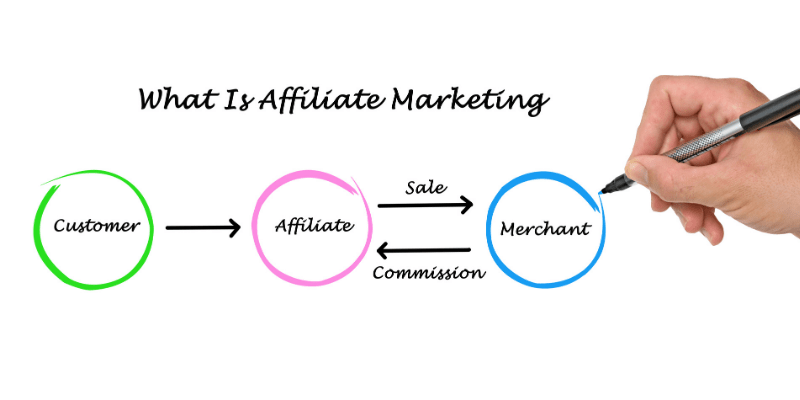According to market research, affiliate marketing is projected to be a $6.8 billion industry by the end of 2020, and bloggers will account for a sizeable chunk of that income. And you’re reading this because you want to know about affiliate marketing and how bloggers make money.
It’s actually a very simple process to understand and put into action. It’s a popular way for bloggers to boost their income.
Affiliate Marketing is a convenient and effective way to monetize your blog through promotion of other people’s products. For example, if someone wanted to sell the Book of the Month Club online, the company could pay affiliates (like you) based on referrals.

Who is the merchant?
When we refer to “merchants” in this guide, we mean companies or individuals who sell a product or service.
The merchant has an affiliate program that you join in order to promote their products. A merchant’s affiliate program details the commissions and the terms on how you can market their items.
The Blog Magazine is supported by its audience. When you purchase through links on our site, we may earn an affiliate commission. Full Affiliate Disclosure.
Once approved, the merchant will pay you a cut of any sales made to customers that you referred to them.
One well-known company that uses an affiliate program is Amazon, but there are thousands of merchants with affiliate programs.
In this video example from Affiliate Posts, we learn how affiliate links work. If you can understand what’s happening here, then you’ve grasped the basic concept of affiliate marketing.
The video showed you:
- How to get an Affiliate link
- An example of embedding an affiliate link into blog content
- How a commission is generated from a sale
In the video, two different affiliate programs were shown as an example – Amazon and GetResponse.
Amazon’s program rewards affiliates with small commissions per sale but has a huge inventory of products that you can promote.
GetResponse, on the other hand, pays affiliates more for every lead they generate.
Second, GetResponse is “Software As A Service (SaaS)”, so they have service subscribers rather than product purchasers.
For affiliates, SaaS services are good to promote, because the merchant not only pays for the referral, but they also pay a commission every time the subscriber renews their service.
You’ll find there are thousands of affiliate programs you can join for all types of products and services, in any industry.
How does a merchant know you sent the buyer?
When you join an affiliate program, you put a merchant’s affiliate links and promotional materials on your website. These include a unique tracking code so that the merchant can identify buyers coming from your website.
How much will the merchant pay?
The commission will depend on the terms and conditions of the affiliate program.
Some programs, such as Bluehost, are a bounty system. If you refer one customer, you get a fixed $65. If you refer a larger number of customers in set time periods, your bounty amount increases.
Now you see why so many Bloggers seem to recommend Bluehost!
In contrast, stores like Amazon pay a percentage of the final sale. Amazon products usually have around 2-5% commission rates, although the wider range is 1-12%.
When does the merchant pay?
Payment schedules vary depending on the affiliate program. You’ll find this specified in the terms and conditions. It can vary from anything between a week to three months.
How do you get paid?
These days, it’s rare to get paid by paper check. Most merchants settle digitally via a payment provider like Paypal or Payoneer or by depositing the money to your bank.
Are there any restrictions on I can promote the products or services?
The terms of the affiliate program will outline the conditions upon which you can promote the products or services. Be sure to check them out thoroughly before starting your promotional activities.
Avoid any promotions that are against the rules and make sure to always communicate with the affiliate program manager if unsure.
What are Affiliate Cookies?

If your affiliate link gets clicked and the prospective customer goes to the merchant’s website, then a text file (known as a Cookie) is stored on their computer.
This Cookie contains your unique affiliate ID. The time between the creation of the Cookie and its expiration is known as the Cookie Life.
Cookie Life is worth understanding, so let’s look at a real-life example of how it works.
- Imagine for a moment; you are a mental health blogger.
- You sign up to the Ultimate Bundles Affiliate Program (Ultimate Bundles sell bundles of courses, eBooks, etc., including a bundle related to mental health)
- In the Ultimate Bundles Affiliate Program terms, it states “When a reader clicks one of your affiliate links, it places a cookie in their browser. If they purchase right away or within 30 days after clicking, you will earn a commission on their sale.”
- You write a blog post about mental health.
- Within that blog post, you insert a link to Ultimate Bundles’ mental health product bundle.
- Somebody (let’s call them Jim) reads your Blog and clicks on the link to the Ultimate Bundles product.
- A Cookie is created and stored in Jim’s browser.
- Jim doesn’t buy right away, but bookmarks the product page for future reference.
- 10 days later, Jim returns to the page and buys the product.
- You receive a commission.
In the example, you’ll notice that the customer (Jim) didn’t convert on Day One. Instead, he came back to purchase within the Lifetime of the Cookie (30 days).
If Jim had returned 31 days later, you would not make any commission.
Regarding Cookie Life, 30 days is fairly average.
Ultimate Bundles Affiliate Program
Products: Visit: Ultimate Bundles
On a side note, the Ultimate Bundles Affiliate Program is a good place to start for new bloggers. Their affiliate portal includes useful training videos, tips from successful affiliates, and a range of quality marketing materials to help you promote their stuff. It’s 100% free to join!
Affiliate Marketing For Bloggers Summary
In this article, we covered the basic concept of Affiliate Marketing for Bloggers and the process involved.
- Decide on a product or service you wish to promote. Choose carefully, as the products and services you pick will reflect your overall blog’s niche or an individual blog post’s subject.
- Find merchants that match up with the items you wish to advertise and join their affiliate program.
- Promote the merchant’s offerings across your site, in blog posts, and on social media.
- Get paid for results.
If any of the terminology relating to Affiliate Marketing isn’t clear. Check out the Affiliate Marketing Glossary for an explanation of terms.

